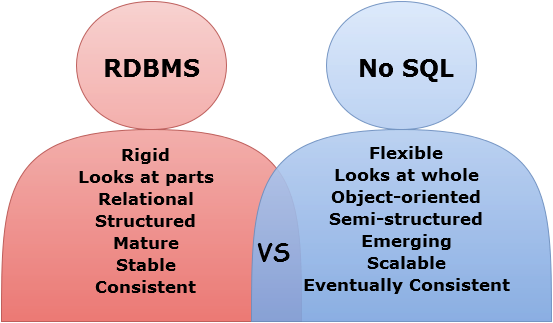Why is NoSQL needed when RDBMS is proven?

NoSQL is favored to RDBMS in today’s fast-paced market environment. This is because NoSQL addresses accelerated change more successfully than RDBMS, which is actually not built to face today’s shifts and challenges.
Evolution of Evidence
The majority of NoSQL publications revolve around the issue of RDBMS vs. NoSQL databases.
NoSQL refers to a wide range of various database technologies that were created in response to the demands of developing modern applications. Developers deal with applications that generate vast amounts of new, rapidly evolving data forms including structured, semi-structured, unstructured, and polymorphic data.
RDBMS is an abbreviation for Relational Database Management System. The information is organized into database areas, tables, and documents. Database table rows exist in each RDBMS table. One or more database table fields can be contained in each row of a database table. As long as the volume of data isn’t prohibitively large, there are compelling reasons to use an RDBMS. Nonetheless, there are specific and basic explanations why conventional RDBMS implementations cannot scale beyond a certain number of database nodes, which is painful. As a result, one must determine when and why to use RDBMS.

Is it better to be organized or unstructured?
Although data longevity is an essential feature of an RDBMS, it is not a differentiator as compared to other solutions. The design of RDBMS is table-based; this is not a feature, but rather a method of storing data. Although some applications could benefit from this, the majority of them are basic, akin to excel spreadsheets. However, to create complex entities, the existence requires a relational definition between tables and rows. Change occurs regularly these days, and data modeling is a significant task due to the time and money that a relational database would necessitate. Unfortunately, by using a relational database, even simple changes like inserting or deleting a column in a table can become a million-dollar challenge.
From CIOs to developers, everybody has discovered that RDBMS is clearly not built for today’s data challenges. As a result, there has lately been an influx in data as well as new database products on the market. Per year, the list becomes longer and longer. In reality, the pattern has been going on for quite some time.
The Digital Economy
The corporate climate is transforming rapidly as industry after industry moves to the Digital Economy. It is a web-powered economy as well as other 21st-century innovations such as social, electronic, analytics, cloud, and big data, colloquially known as SMAC. The web, smartphone, and Internet of Things applications are at the core of any Digital Economy sector. They are the key means by which companies communicate with their customers and conduct more and more of their operations. The interactions that companies have through such applications have a significant impact on the retention and engagement of their customers.
RDBMS and NoSQL are born
Relational databases originated in the age of enterprise software and mainframes, long before the internet, big data, cloud storage, mobile computing, and the Modern Economy. Oracle did, in effect, introduce the first commercial implementation in 1979. The databases are designed to operate on a single disk, so the larger the better. The only way to increase database size was to upgrade the servers’ processors, storage, and memory to scale up.
The advent of NoSQL is a product of the Internet’s and web apps’ explosive development and rise. Google published BigTable research in 2006, and Amazon published Dynamo research paper the following year. The databases were created to address the needs of the next generation of companies.
Adaptability
RDBMS is the greatest impediment to agility and, due to their fixed data architecture, they do not help agile implementation as well. However, with NoSQL, an organization can create applications easily. As the advancement of the modern web, smartphone, and internet of things technologies becomes more important than ever, developers must create quicker apps and services than ever before. Speed is important, but so is agility, since this software develops at a far faster rate than older systems like ERP.
As-is data storage is supported by NoSQL databases. Unstructured data constitutes the vast majority of data in an enterprise environment. Most NoSQL databases may handle unstructured text indexing as a native function or as part of an integrated range of services. The ability to handle unstructured text improves knowledge and can aid companies in making better decisions. For intermediate users, for example, there is support for several languages with facetted scanning, word-stemming, and snippet capabilities. Dictionary and thesaurus support is also included in advanced features. Furthermore, using search warning activities on data ingest, one could remove named entities from directories such as those containing sites, persons, and organizations, allowing text data to be easily classified, marked, and scanned.
Agnostic in terms of schema
NoSQL databases’ schema-agnostic nature enables them to handle transition over time. They are extremely adaptable, and there is no longer a need to rewrite ETL routines if the XML message structure between the systems changes. Some NoSQL databases go much further to have a universal index for both structure and text contained in the content.
Who is making use of it?
Several Global 2000 organizations have recently addressed the use of NoSQL for mission-critical applications. Tesco, Europe’s largest supermarket, is one example. It uses NoSQL for eCommerce, product catalogs, and other applications. Another example is Ryanair, the world’s busiest airline, which uses NoSQL to fuel its smartphone application, which services over three million people. Marriot also uses NoSQL for its reservation system, which processes $38 billion in bookings each year. There are only a handful of companies that use the NoSQL technology around the world.
NoSQL databases
There are four kinds of NoSQL: key-value, columnar, text, and graph. Key-value databases are well-suited to applications that often have tiny reads and writes, as well as basic data models. The values contained in key-value databases can be plain scalar values like integers or Booleans, or they can be hierarchical data types like lists and JSON structures. Key-value databases, in general, have basic query facilities that allow you to look up a value by its key. Some databases support search capabilities that seem to offer more functionality. Columnar or column family databases are another category that is optimized for large amounts of data, high availability, and read and write capacity. Google, for example, launched Bigtable to address the demands of its service. Cassandra was created by Facebook to support its Inbox Search feature. These databases are hosted on networks of servers.
Rather than being a substitute for relational databases, text-style databases have an alternative. Each has a function and adds to the number of options available. One specific example is MongoDb documentation, which discusses a trend known as Array of Ancestors, which speeds up access to relevant data while entering records. The graph database is the fourth kind. It stores and represents data using graph structures for semantic queries with edges, nodes, and resources. The main idea is a graph, which explicitly connects data objects in the shop. Neo4j, AllegroGraph, and other examples are available.
There is no question that NoSQL has many advantages for the growth of next-generation technologies in the Big Data era. New applications, usage cases, and data requirements have often outgrown the legacy RDBMS model and necessitate a different form of engine, which NoSQL provides.




